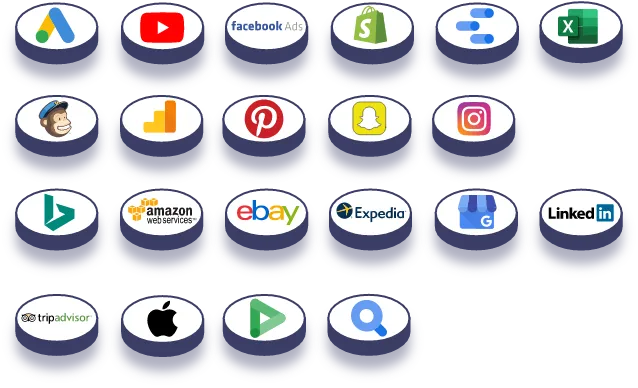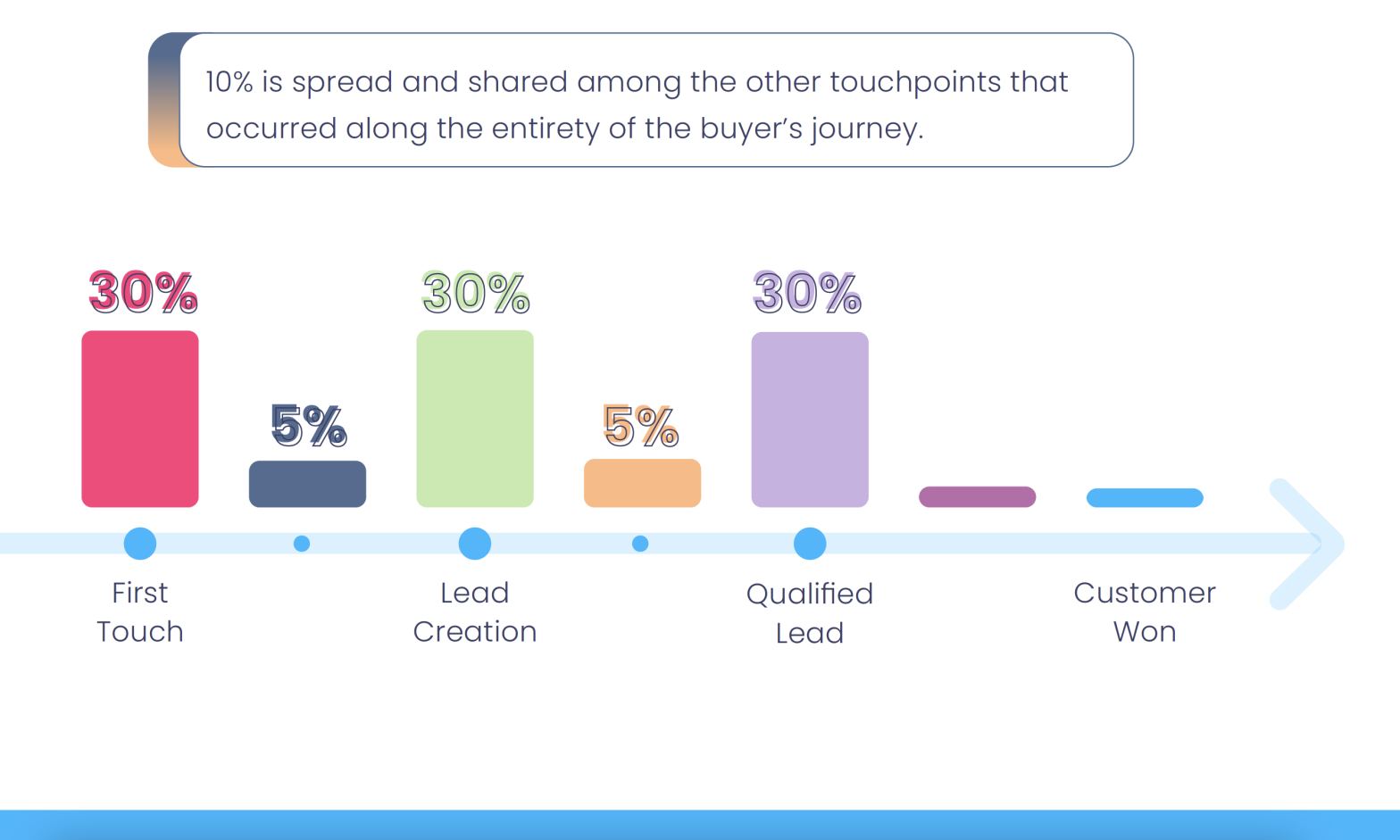Marketing AnalyticsThe Anatics Guide to Multi-Touch Attribution Models
July 12, 2022

Next, we have multi-touch attribution models, where the credit for a conversion is distributed across multiple touchpoints in the customer journey. There are several different multi-touch attribution models – with one subcategory being position-based models. We will be covering the most utilized models in this article.
Linear Attribution
In linear attribution, the credit for conversion is spread across touchpoints along the length of the customer journey. With this model, all interactions are considered and afforded the same amount of credit. Linear attribution is also very easy to understand from a mathematical perspective.
With linear attribution, every touchpoint receives the same amount of credit for the conversion. Mathematically, the formula is easy to understand and execute: 100 (% of the credit) divided by the number of touchpoints in the conversion path equals the amount of credit afforded to each touchpoint.
Linear attribution works well for those looking for a good starting point to considering and evaluating all the touchpoints along a conversion path. It is an excellent way to get a macro-level grasp of your marketing strategy as it takes all touchpoints into account and assigns credit accordingly.
Linear attribution is particularly useful for those who want insights into which of their marketing efforts are effectively guiding prospects and leads through their funnel. It also gives insights into which touchpoints are not as effective, meaning that they need further optimization.
Now, it is also important to evaluate how a linear attribution model might skew your view of the customer journey, as each touchpoint is afforded the same amount of credit. There is very little nuance to a linear attribution model, as part of attribution modeling is examining how essential each touchpoint is in a customer’s decision to convert. Thus, with linear attribution, you might be missing out on valuable insights into your marketing strategy.
Time Decay Attribution
Time decay attribution, as with linear attribution, spreads credit across all the touchpoints of a conversion path. The difference is that with time decay attribution, the amount of credit that is given to each individual touchpoint decreases (decays) further back in time that the interaction was.
The logic behind time decay attribution is that the first touchpoint – or interaction – planted a seed, and that the consumer’s interest grew over time through repeated exposure through a variety of marketing efforts and strategies across different channels. Thus, time decay attribution assigns conversion credit in a manner that interprets your prospect’s interest and commitment “growing” over time.
With a time decay model, there are several benefits that you can reap from its implementation. Vitally, it affords credits to all touchpoints involved in a conversion. Additionally, the closer that a touchpoint is to the conversion, the higher the value it is afforded – thus, preference in a time decay model is given to those touchpoints that do the most “closing” work of a sale. Lastly, time decay highlights the fluctuations in individual channels’ activity.
But there are problems that marketers can run into if they solely rely on a time decay attribution model. Some of these problems include that the mathematics involved in a time decay model can be quite complex, despite its consistency. It also might not be as accurate as it could be, given how the modern customer journey is becoming increasingly complex.
U-Shaped Attribution
U-shaped attribution models are one of several options for a position-based attribution model. If you look at the model from a graphical perspective, it resembles a U in terms of how credit is attributed for a conversion.
The reason that U-based attribution is a position-based model is because it is a multi-touch model where the credit afforded to each touchpoint is determined by its position in the marketing and sales funnel. They are an easy to understand model, wherein the first touchpoint is assigned 40% of the credit, with the last touchpoint receiving 40% as well; the remaining 20% is then split equally between all other touchpoints – no matter how many there might be.
With U-shaped attribution, you can gain insight into how all your various marketing efforts and channels work together to bring in new customers. It highlights the critical first and last touchpoints of the customer journey, demonstrating where your resources are best allocated. With this knowledge, you can better guide future marketing investment into high ROI opportunities that garner top results.
However, you do need to consider how restrictive U-shaped attribution can be and that it might not be the best fit for your business. While it affords insight into the pivotal points of the customer journey, it also gives you a highly simplistic view of it.
W-Shaped Attribution
In W-shaped attribution models, it falls into both of the categories of multi-touch and position-based models. It breaks down credit among the different touchpoints of the customer journey along the following lines:
- 30% of conversion credit is assigned to the first touchpoint
- 30% of the credit for conversion is assigned to the lead creation touchpoint
- 30% of the credit goes to the opportunity touchpoint (meaning the final touchpoint before conversion into a paying customer occurs)
- 10% is then spread between the remaining touchpoints that occurred along the course of the customer journey.
With W-shaped attribution, you will gain a better understanding of your marketing channels and how they interact with each other, which touchpoints are useful at different stages of the sales and marketing funnel, and where you can optimize for better results. Once you know how much revenue each individual touchpoint brings in, you can better refer to its initial cost and know what your profit margin is on each touchpoint.
W-shaped attribution works exceptionally well for B2B companies with a clear funnel that prospects move through. It places emphasis on the critical touchpoints in the buying journey. Those being: the first touch, lead creation, and opportunity creation. While it gives you oversight over the entirety of your customer journey, it also affords credit in a manner that makes sense given the importance of each touchpoint in relation to the conversion.
Z-Shaped Attribution
The last multi-touch model we will be outlining is another position-based model: Z-shaped attribution. This model gets its name from the shape it forms when you look at it from a graphical perspective. As it is a position-based model, it affords credit to touchpoints in a manner that is dependent on their location in the customer journey and marketing/sales funnel.
In a Z-shaped attribution model, the four most important touchpoints (first touch, lead generation, opportunity creation, and closing touch) are each assigned 22.5% of the credit for the conversion. The remaining 10% is then equally split amongst the remaining touchpoints.
Z-shaped attribution is effective with how it breaks down conversion credit, taking much of the guesswork out of the equation. The math involved in the model is a straightforward formula and serves to highlight key touchpoints while still recognizing the contribution of other touchpoints. Given that it is a multi-touch attribution model, that means it takes all touchpoints in the customer journey into account – it allows for deeper insight than a single touch model would.
Summary
With attribution modeling, you can begin to analyze your customer journey through the lens of which touchpoints are proving effective at different stages of the sales and marketing funnel. While the history of attribution modeling is a long one, it still has its applications in today’s marketing landscape. It allows you to evaluate your marketing strategies, making decisions based on which ones are most effective.
Multi-touch models are often considered to be more comprehensive, offering deeper insights, than their single-touch counterparts. However, they tend to be much more complex than a single-touch model and can be difficult to set up. But you need to remember that each has its own benefits and weaknesses, which is why you need to consider using them in comparison with each other.
Looking for more information on attribution modeling’s impact on marketing performance? Then you need Anatics’ The Attribution Modeling Playbook for more information on the role that attribution modeling plays in a data-driven marketing strategy. Download your free copy of the ebook today!


